As a custom webbing manufacturer, we regularly help brand manufacturers and product developers integrate custom logos into jacquard nylon straps. Many clients approach us uncertain about the technical possibilities or how to prepare designs for optimal results. We’re writing this guide to clarify what’s achievable and help you make informed decisions about jacquard logo webbing.
Yes, jacquard nylon straps can feature custom logos through specialized weaving processes that integrate branding elements directly into the fabric structure. Jacquard loom technology controls individual threads to create complex patterns, text, and multicolor designs that become permanent parts of the material.
This guide covers jacquard logo webbing design, production, cost, and applications—helping you specify the right solution for your branding needs.
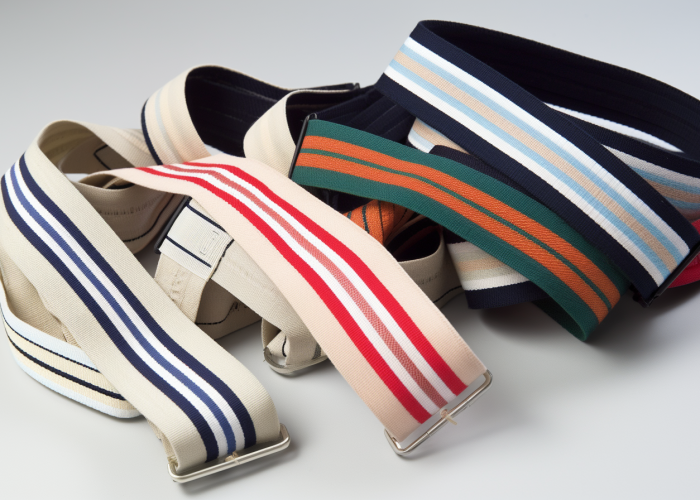

Webbing manufacturing expert with 15+ years of experience helping product developers build high-performance straps for industrial, medical, and outdoor use.
For custom jacquard logo webbing, you need vector files in EPS or AI format at minimum 300 DPI resolution, with clearly defined color separations and no gradients or photographic elements. Vector formats ensure your logo maintains crisp edges during loom programming, while proper resolution prevents pixelation.
Required File Specifications:
From our manufacturing experience, 90% of production delays stem from inadequate file preparation. Vector files allow our jacquard loom programming to accurately translate designs into individual thread controls. Raster files (JPG, PNG) often contain compression artifacts that create blurred or distorted logos.
The jacquard weaving process requires distinct color boundaries—gradients and photographic images cannot translate into the binary thread control system. We’ve seen clients attempt complex photographic logos only to discover the woven result lacks clarity their brand demands.
Design Takeaway: Provide vector files (EPS/AI) with solid colors, avoid gradients, and ensure text meets minimum size requirements. Our engineering team can review your files during consultation to identify potential issues before production.
Jacquard logos are woven directly into nylon straps through computerized loom programming that controls individual warp and weft threads to create patterns within the fabric structure itself. Unlike printed or embossed logos, jacquard weaving integrates your design as part of the material composition, making it permanent and fade-resistant.
Jacquard Weaving Process:
Our jacquard loom technology operates like a computerized weaving system, where your logo file is converted into precise thread-by-thread instructions. The loom controls thousands of individual threads, raising or lowering each one to create your logo pattern within the nylon fabric. This process achieves complex multicolor designs with sharp detail definition that remains permanent throughout the webbing’s lifespan.
Unlike surface treatments that can peel or fade, jacquard weaving creates logos that are structurally integrated into the material. The process allows for intricate text, symbols, and patterns while maintaining the nylon’s original strength and flexibility characteristics.
Design Takeaway: Jacquard weaving creates permanent, fade-resistant logos that become part of the fabric structure. This integration method ensures your branding withstands heavy use, washing, and environmental exposure without degradation.
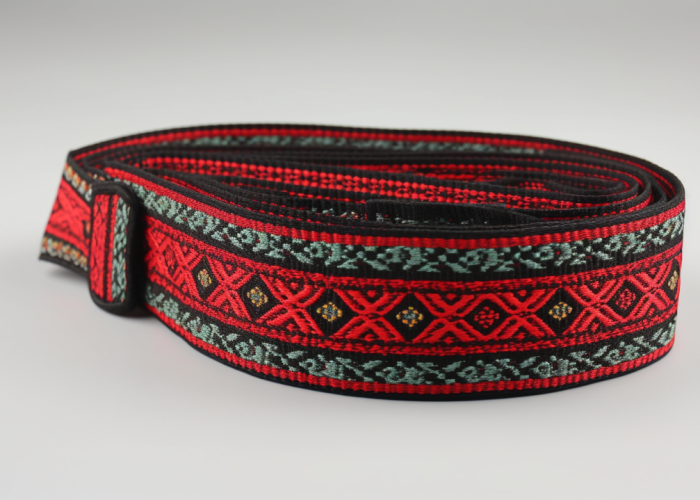
Photographic images, fine gradients, designs with elements smaller than 1.5mm, and logos requiring more than 8 colors typically don’t work well on jacquard webbing due to thread control limitations. The binary nature of jacquard weaving—threads are either up or down—cannot reproduce smooth color transitions or extremely fine details.
Problematic Design Elements:
From our manufacturing experience, clients often overestimate jacquard’s photographic capabilities. We’ve processed logos with hair-thin serif fonts that completely disappeared in the woven result, and gradient-heavy designs that became blocky, pixelated patterns. The most problematic designs are corporate logos with fine legal text or detailed emblems with intricate shading.
Successful jacquard logos use bold, simplified graphics with clear color separation. Think of jacquard weaving like 8-bit pixel art—each thread intersection is essentially one “pixel” that’s either on or off. Designs that work best feature strong contrast, simple shapes, and readable typography that maintains impact even when simplified.
Design Takeaway: Simplify complex logos by removing gradients, thickening thin elements, and reducing color counts. Our design consultation can help adapt your existing logo for optimal jacquard reproduction while maintaining brand recognition.
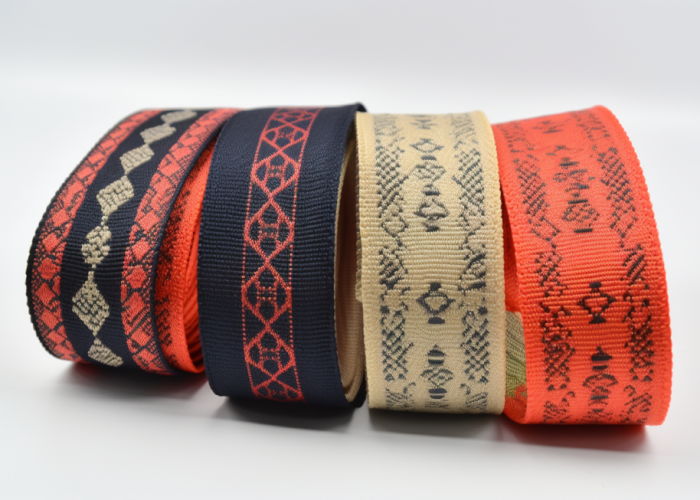
Logo complexity, color count, webbing width, order quantity, and production timeline are the primary factors affecting jacquard webbing pricing, with setup costs typically representing 60-70% of small order expenses. Understanding these variables helps you budget effectively and optimize your specifications for cost efficiency.
Key Pricing Factors:
Logo complexity directly impacts loom programming time—simple 2-color text logos require minimal setup compared to 6-color emblems with multiple design elements. Each additional color requires separate thread positioning and tension adjustments, increasing both setup time and material costs.
Order quantity creates the most dramatic cost variations. Setup costs remain fixed regardless of quantity, so smaller orders carry higher per-unit expenses. A minimum order of 1,000 meters typically optimizes cost-efficiency while maintaining reasonable total investment for most product development projects.
Production timeline affects pricing through capacity allocation. Standard 3-4 week lead times allow efficient production scheduling, while rush orders requiring 1-2 week turnaround may incur 25-40% premium charges due to expedited processing requirements.
Design Takeaway: Optimize costs by simplifying logo designs, ordering efficient quantities, and planning production timelines in advance. Our quoting process provides transparent cost breakdowns to help you make informed budget decisions.
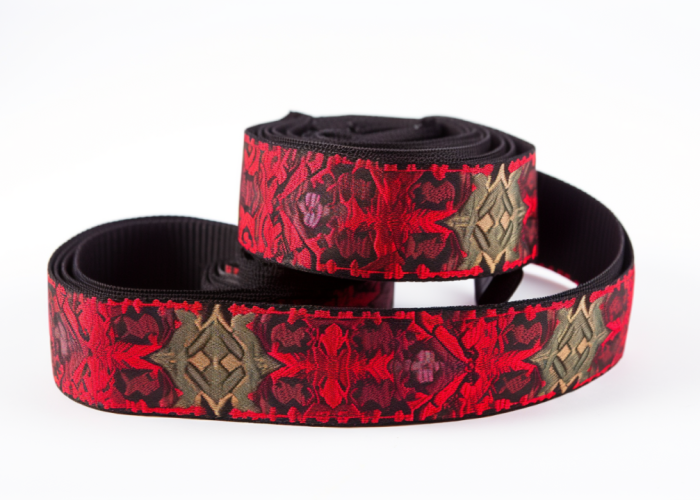
Yes, jacquard webbing significantly outperforms printed logo options in durability testing, with woven logos maintaining 95%+ clarity after 500 wash cycles compared to printed logos which show 40-60% degradation. The structural integration of jacquard logos into the fabric prevents peeling, cracking, or fading that commonly affects surface-applied printing methods.
Durability Comparison Data:
Independent testing shows printed logos begin deteriorating after 50-100 wash cycles, with edges lifting and colors fading. Screen-printed webbing particularly struggles with flexibility stress, developing cracks where the strap bends repeatedly. Heat transfer applications perform better but still show measurable degradation after 200 wash cycles.
Jacquard weaving eliminates these failure modes because the logo IS the fabric structure. There are no adhesives to fail, no surface coatings to wear away, and no applied materials to separate from the base webbing. This makes jacquard ideal for high-use applications like pet leashes, safety harnesses, and outdoor gear where logo durability directly impacts brand perception.
Design Takeaway: Choose jacquard for applications requiring long-term logo durability and professional appearance. The higher initial investment pays off through extended product lifespan and consistent brand presentation.
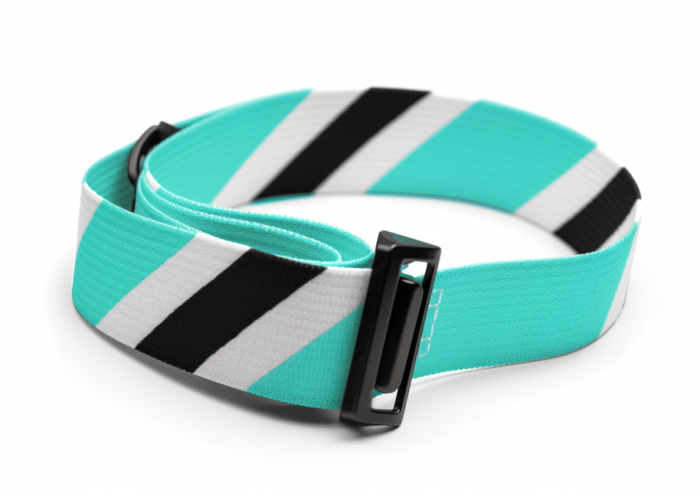
Pet product manufacturers, outdoor gear companies, and safety equipment producers benefit most from jacquard logo webbing due to their need for durable branding that withstands heavy use, weather exposure, and frequent washing. These industries require logos that maintain professional appearance throughout extended product lifecycles.
Top Industries Using Jacquard Logo Webbing:
Pet industry applications see the highest performance benefits because products endure daily outdoor exposure, frequent washing, and constant flexing. Dog leashes with jacquard logos maintain crisp branding after months of park visits and weekly washing, while printed alternatives show wear within weeks.
Outdoor gear manufacturers value jacquard for backpack chest straps and equipment webbing that face UV exposure, moisture, and temperature extremes. The permanent logo integration ensures brand visibility remains consistent regardless of environmental conditions.
Safety equipment applications require logos that won’t compromise structural integrity while meeting visibility standards. Jacquard weaving maintains both regulatory compliance and brand identification without adding bulk or weak points to critical safety components.
Design Takeaway: Jacquard logo webbing excels in applications where durability, weather resistance, and long-term brand visibility are essential. Consider jacquard when your product’s logo must perform as reliably as the webbing itself.
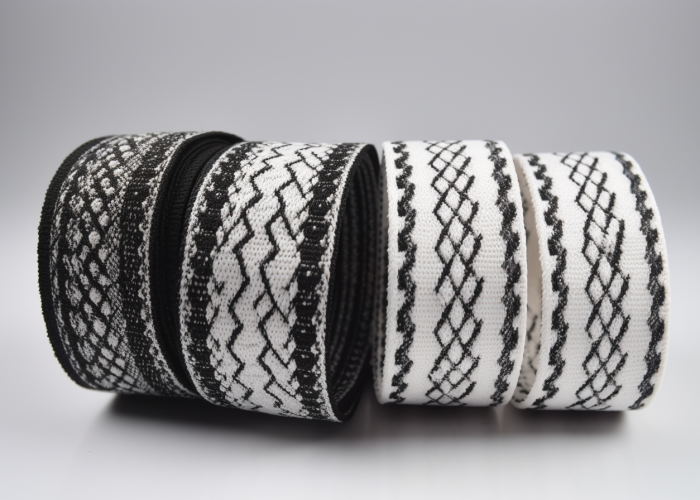
Custom jacquard orders must meet OEKO-TEX Standard 100 for textile safety, maintain ±2% dimensional tolerance, and achieve Grade 4-5 color fastness ratings under ISO testing protocols. These standards ensure consistent quality, regulatory compliance, and reliable performance across production batches.
Key Manufacturing Standards:
Quality control protocols monitor every production stage from thread selection through final inspection. Our tensile testing validates webbing strength meets specifications while color matching ensures consistency across production runs. Each batch undergoes wash fastness testing to verify logos won’t bleed or fade during end-use.
OEKO-TEX certification requires comprehensive chemical testing of all materials, ensuring finished webbing contains no harmful substances. This certification is particularly important for pet products and children’s accessories where safety regulations are stringent.
Production documentation includes material certificates, test reports, and dimensional verification for each order. This traceability supports quality audits and regulatory compliance while providing evidence of manufacturing standards adherence.
Design Takeaway: Our manufacturing standards ensure your jacquard webbing meets industry requirements for safety, durability, and quality. Standard compliance documentation supports your product certification and quality assurance processes.
Jacquard nylon straps effectively feature custom logos through integrated weaving technology that delivers superior durability compared to printed alternatives. For applications requiring permanent, fade-resistant branding, jacquard weaving provides the optimal solution for professional appearance and long-term performance. Contact us to explore manufacturing solutions tailored to your custom jacquard logo webbing requirements.
Jacquard logos maintain 95%+ clarity after 500+ wash cycles and show minimal fading after 1000+ hours UV exposure. Printed logos typically degrade 40-60% within 100 wash cycles, making jacquard 5-10 times more durable for long-term applications.
We achieve close color matching using available thread colors, typically within industry-standard tolerances. Provide Pantone references or thread samples for best results. Some color adjustments may be necessary based on available nylon thread options.
Vector files (EPS, AI) at 300+ DPI work best. Avoid raster formats (JPG, PNG) which can cause pixelation. Include color specifications and ensure all design elements meet minimum size requirements for optimal weaving results.
Minimum orders typically start at 1,000 meters to optimize cost-efficiency. Smaller quantities are possible but carry higher per-unit costs due to fixed setup expenses. We can provide detailed cost breakdowns for various quantity levels.
Yes, our jacquard webbing can meet OEKO-TEX Standard 100, specific tensile strength requirements, and other safety standards. We provide certification documentation and testing reports to support your product compliance needs.
Most logos require simplification for jacquard weaving. Remove gradients, thicken lines to minimum 2mm, ensure text is at least 10mm tall, and limit colors to 6 maximum. Our design team can help adapt your logo while maintaining brand recognition.